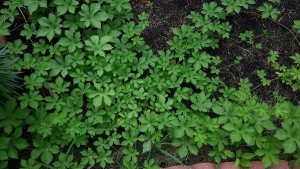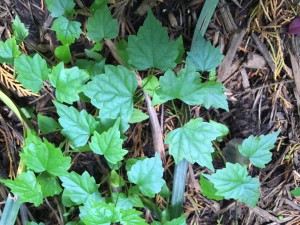Gardeners: Un-mulch your poor smothered trees
Bruce in Gaithersburg writes: “What do you think I should do with my American Hornbeam? We’ve had it for four or five years and it was doing great; now there’s a lot of dead wood. Should I prune out the dead parts?”
Bruce attached a photo that shows a tree with decent green growth down low and a lot of dead branches up top. The photo also shows a wide layer of mulch in the background that’s the color of a Burger King, which led me to ask for a follow-up photo of the base of the tree.
… Which reveals a mound of that same fast-food colored mulch piled up against the bark, covering the lower portion of the tree — a death sentence, especially during continued wet spells, like the ones we’ve been enduring. That bark has been kept sopping wet a long time now; and you know how you can get Athlete’s Foot ….
So forget about the top for now and look low. Before you do anything else, carefully dig away that mulch with well-gloved hands until all of the bark is exposed to light and air, and hope that it hasn’t rotted away in a complete circle yet. Don’t use any tools. You don’t want to cause any further damage if the bark can be salvaged.
Volcano mulching kills trees. Period.
The lead arborists of the two largest national tree care companies — The Bartlett Expert Tree Company and Davey, The Care of Trees — have repeatedly assured me that more than half of the tree deaths they see are due to improper mulching, specifically mulch covering the lower portion of the trunk.
Yes, such a decorative look is popular. And yes, “everyone does it.”
It wasn’t that long ago that almost everyone smoked, when it was routine for people to smoke cigarettes everywhere except in church. Remember the ashtrays in college classrooms and hospital rooms? Volcano mulching is today’s version of smoking, and it makes as much sense as those ashtrays next to hospital beds.
It’s not rocket science. Covering the base of a tree invites rot to decay the bark and provides cover for insects, mice and voles to nibble away and destroy it. And once that bark is gone in a complete circle around the tree, “it’s dead, Jim.”
If you have mulch covering the bark of a tree, scrape that mulch away ASAP and expose the trunk and the top of the root flare. Look in the woods. You’ll never see a single tree that looks like a lollipop! That area when the roots meet the bottom of the trunk needs to be open to the air. Cover it with mulch and the rot begins.
Then prune away the dead branches. Dead wood should be removed at any time of the year, and its removal will ease the stress on the tree. Prune off the entire dead branch (in sections if it’s big), but always leave the collar where the branch meets the tree attached to the tree. Do not cut flush to the trunk.
To help the poor thing further not die, do not give it tree spikes or other chemical fertilizer — that’s only going to stress it more. And don’t apply fertilizer or herbicides to the lawn nearby. Just cut the lawn correctly and leave the clippings behind and the lawn will be fine.
And if you feel you have to mulch a poor tree, use black yard-waste compost (like Maryland’s LeafGro), and don’t touch the trunk. Begin mulching 6 inches to a foot away from the trunk and go out in a circle as far as you can. That’s the way to mulch a tree to life, not death.
Where did my garden go?
Vangie up near Baltimore writes: “We live in a rental community that has raised garden beds for the use of the tenants. We started in April with kale, collards, broccoli and herbs. In May we planted marigolds, nasturtiums, garlic, squash, pumpkins, lettuce, peppers and tomatoes. Then the landscaper “accidentally” mowed it all down along with some unused plots that had gotten very weedy. Any tips for replanting so late?”
Yes, but first, your timing is off in a couple of instances: Garlic is planted in the fall, not the spring (install individual cloves 6 inches deep in September), and lettuce is a spring and fall only crop — it can’t take summer heat.
Now, rush to a local independent garden center! Many high-quality nurseries have been keeping the last of their tomato and pepper plants alive and growing in tune with the season by moving them up into bigger pots so that people like you can still have a crop this year.
Install the replacement plants in the evening to lessen the transplant shock. And don’t delay. This might be the last weekend you’ll be able to buy summer vegetable plants!
“You think you used enough water there, Butch?”
Jamie in Fredericksburg writes: “I’m having some issues with my pepper plants: green and red bell peppers, a ghost pepper, and two jalapeños. {McGrath’s note: There is no such thing as a “green bell pepper.” All bell peppers turn a final color of red, yellow, orange or chocolatey-brown when ripe. Green peppers are unripe and contain almost no nutrients.}
Jamie continues: “The leaves started yellowing and falling off just around the time they started blooming. Then the blooms fell off! I have them in a raised bed with a drip irrigation system that runs about an hour before dark.”
Turn off the drip, Jamie, you are drowning your poor plants! Heavy rains have already greatly stressed many plants and your added water is doing them in.
If you think you’re going to have to replace them, run to a local independent garden center now while there’s still that chance that they’re holding onto some big last minute plants. And if you do replant, get a big bag of perlite and mix it into the entire bed to improve drainage.
And lawn owners, turn off your watering systems if they don’t have automatic rain sensors! And don’t turn them back on until Noah stops building that big boat in the middle of DuPont Circle. Overwatering is the single biggest human cause of plant death.
Vine whines

I received two very similar emails this week, each with a photo.
Lisa in Sterling writes: “Can you identify this plant taking over my garden? It’s a real creeper but has no blooms.”
Brennan in D.C. echoes: “Do you recognize this plant? Some sort of weed? Could the seeds have been in the hardwood mulch I put down?”
I’m going to guess that Lisa’s creeper is Virginia creeper, a native but invasive vine that some people think looks like poison ivy, but it has five leaves, not three. Brennan’s looks more like wild grape, another invasive vine that’s overrunning area forests.

But the only ID you need with such plants is to confirm that they’re not poison ivy. “Leaves of three, let it be.” (And then email McGrath for safe removal instructions. Don’t spray poison ivy with herbicides; the dead vine will still give you the same bad rash.)
You should always pull these other vining plants out as soon as they appear in your landscape. These and other invasive vines are running amok (some say due to increased levels of carbon dioxide and climate change. Doesn’t matter to me: Amok is amok), and they will become very difficult to control if you let them keep growing. Wild grape, for instance, will develop Tarzan-like vines in a surprisingly short time. So pull them as soon as you see them.
And although wood mulch is bad, it’s generally birds to blame when vines pop up. They eat the seeds and then … well they do what birds do.







